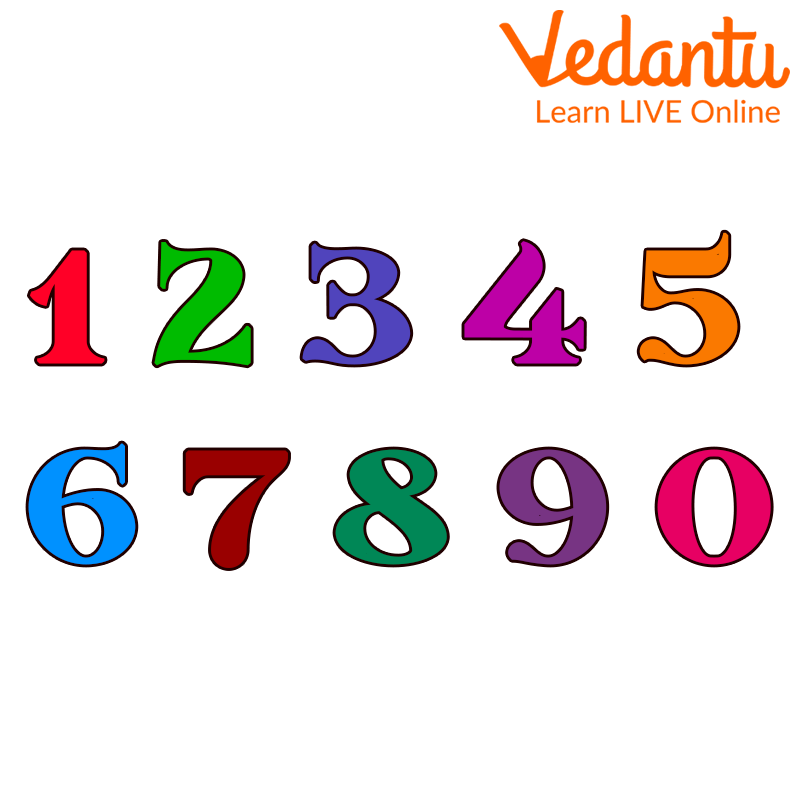




Key Rules to Identify the Smallest Number in a Set
The smallest number in a given group of numbers will be the smallest number. Like 1 is the smallest natural number, 0 is the smallest whole number, and so on. The numbers can be arranged in order, ascending or descending. By arranging numbers in ascending order, we will get the smallest number and by arranging numbers in descending order, we will get the greatest number.
What is a Digit?
A positional numeral system uses a single symbol, the numerical digit, either individually or in combination to represent numbers. The term "digit" refers to the ten symbols of the common base-10 numeral system, or decimal digits, to which the ten digits of the hands correspond. The number from 0 to 9 are called digits. For example, the numeral 321 coonsists of 3, 2, and 1 digit.

Digits
What is the Ascending and Descending Order?
Ascending Order: When numbers or things are arranged from lowest to highest or from small to big, then the order will be ascending order.

Arrangement of People in Ascending Order of their Height
Descending Order: When numbers or things are arranged from highest to lowest or from big to small, then the order will be descending order.

Arrangement of People in Descending Order of their Height
How to Form the Smallest Number from given Digits?
Arrange the given digits in ascending order to get the smallest number.
For example, the given digits are 3, 2, and 4.
Step 1: Arranging in ascending order, we get the smallest number that is from small to big.
Step 2: Thus, its ascending order will be 2, 3, 4.
If zero is one of the digits when composing a smaller number, it is written after the highest place. For example, given digits are 3, 0, and 5.
The smallest is 305. Because if we make the digit 035, then it would be a 2-digit number which is not required as we have to make the smallest 3-digit number only.
Interesting Facts About Numbers
0 (Zero) is the smallest whole number.
1 (one ) is the smallest natural number.
Zero is the smallest non-negative rational number and non-negative real number.
The smallest 5-digit number is 10000.
The smallest 7-digit number is 1000000.
Solved Examples
1. Form the 3 smallest digit numbers from the given digits.
2,4 and 5
6,8 and 4
3,7 and 9
Solution:
a. 2,4 and 5
To get the smallest number, arrange them in ascending order; you will get 2,4,5, so the smallest number is 245.
b. 6,8 and 4
To get the smallest number, arrange them in ascending order; you will get 4,6,8, so the smallest number is 468.
c. 3,7 and 9
To get the smallest number, arrange them in ascending order; you will get 3,7,9, so the smallest number is 379.
2. Arrange the following digits in ascending order.
9,4 and 8
3,0 and 7
Solution:
a. 9,4 and 8
Ascending Order: 4,8,9
b. 3,0 and 7
Ascending Order: 0,3,7
3. Arrange the following digits in ascending order.
9,5 and 4
1,0 and 3
Solution:
a. 9,5 and 4
Ascending Order: 4,5,9
b. 1,0 and 3
Ascending Order: 0,1,3
Conclusion
The smallest number from the digits given can be formed by arranging the digits in ascending order. We put the digits in ascending order to get the smallest number. In this article, we have learned that to obtain the smallest number from the given digits, we need to arrange the numbers in ascending order such that the smallest digit comes at the left-most digit and the largest digit is in the rightmost digit. If there is zero, then it must be at the second digit to the left, because if we place zero at the left-most digit, then it is no longer a three-digit number.
FAQs on How to Find the Smallest Number: Step-by-Step Guide
1. How to find out the smallest number?
To find out the smallest number in a set, compare all the given numbers and identify the one with the lowest value. This can be done by arranging the numbers in ascending order—from least to greatest—and selecting the first number in the list. For example, in the set {5, 2, 9, 1}, the smallest number is 1. In mathematics, this process can also be performed using the min function, written as $\min(a_1, a_2, \ldots, a_n)$, which returns the smallest element among the numbers $a_1, a_2, \ldots, a_n$.
2. How to find the smallest number in a list?
To find the smallest number in a list, follow these steps:
- Begin with the first number in the list as your temporary smallest value.
- Compare this value with each subsequent number in the list.
- If you find a number smaller than your current smallest, update your smallest value.
- Continue until you reach the end of the list.
3. Which is the smallest number divisible by 1, 2, 3, 4, 5, 6, 7, 8, 9, 10?
The smallest number divisible by 1, 2, 3, 4, 5, 6, 7, 8, 9, and 10 is called the Least Common Multiple (LCM) of these numbers. To find it, break down each number into its prime factors and take the highest power of each prime:
- 2: $2^3$ (from 8)
- 3: $3^2$ (from 9)
- 5: $5^1$ (from 5 or 10)
- 7: $7^1$ (from 7)
$2^3 \times 3^2 \times 5 \times 7 = 8 \times 9 \times 5 \times 7 = 2520$
So, 2520 is the smallest number divisible by 1 to 10.
4. How to find the smallest 8 digit number?
The smallest 8 digit number is the first number with exactly 8 digits. An 8-digit number starts from $10,000,000$ (one crore in the Indian system). Therefore, $10,000,000$ is the smallest 8 digit number. This concept is often explained in Vedantu classes to help students understand the place value system in mathematics.
5. What is the smallest prime number and why is it important in mathematics?
The smallest prime number is 2. It is significant because
- It is the only even prime number.
- Every prime number larger than 2 is odd.
- Prime numbers are the building blocks of all natural numbers, as every natural number greater than 1 can be factored uniquely into primes (Fundamental Theorem of Arithmetic).
6. How can students find the smallest number using Vedic math techniques?
Using Vedic math techniques, students can quickly compare numbers by:
- Examining digits from left to right to find the smallest value in each place.
- Applying shortcut methods for mental calculations, such as identifying the smallest digit in each column.
7. What is the difference between the smallest number and the least common multiple (LCM)?
The smallest number in a set is the lowest numerical value among the group, while the Least Common Multiple (LCM) is the smallest number that is exactly divisible by every number in a given set. In Vedantu’s math courses, this distinction is highlighted to improve students’ understanding of fundamental concepts like comparison and multiples.
8. How do you find the smallest number between two fractions?
To find the smallest number between two fractions, convert both fractions to a common denominator and compare their numerators. For example, comparing $\frac{3}{5}$ and $\frac{2}{3}$:
- Common denominator for 5 and 3 is 15.
- $\frac{3}{5} = \frac{9}{15}$, $\frac{2}{3} = \frac{10}{15}$
9. What role does finding the smallest number play in solving math problems?
Finding the smallest number is crucial in solving math problems such as:
- Ordering and arranging data.
- Solving word problems involving minimum values.
- Working with algorithms, statistics, and probability.
10. How can Vedantu help students master concepts like finding the smallest number?
Vedantu offers live interactive classes, practice worksheets, and mock tests for students to develop a deep understanding of concepts such as finding the smallest number. Through expert teachers and personalized attention, Vedantu ensures students can:
- Apply strategies for number comparison.
- Use interactive quizzes to reinforce learning.
- Receive instant feedback and doubt clarification.

















